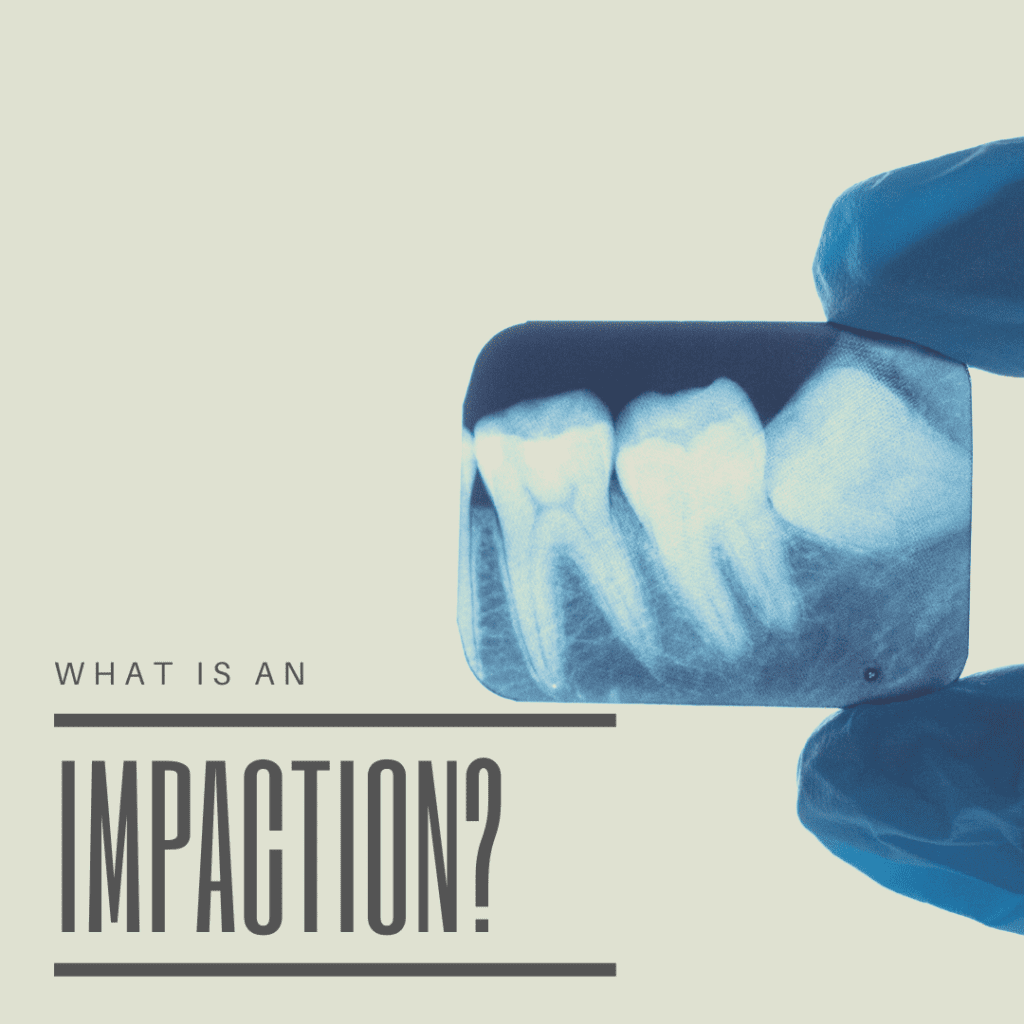Wisdom teeth are the third set of molars in your mouth. They typically start to grow when you’re 17-25 years old, but they can also develop later in life. They may not all come in at once, and some people don’t have all four wisdom teeth. During our evolutionary past, wisdom teeth were essential for chewing on tough foods that made up our diet. However as humans continued to evolve, the oral cavity got smaller so the brain could get bigger. This means that there is now less room in the mouth to accommodate these four extra teeth that are essentially no longer needed.
Impactions are a complication of erupting wisdom teeth. They occur when the wisdom teeth don’t have enough room to come in, causing them to get stuck under the gum line. Depending on how much space is available, wisdom teeth may be partially or completely impacted. A partial impaction occurs when the wisdom tooth can be partially seen above the gums, while a complete impaction is when the entire tooth is trapped below the gums. Both partial and complete impactions can lead to cavities, infections, and even damage to neighboring teeth.
There are four different types of impactions, including:
Vertical Impaction
A vertical impaction is when the wisdom tooth is facing the right way for eruption, however it has been unable to protrude up through the gums. Vertical impactions don’t always require treatment and your dentist will usually monitor them for a period of time to see if the tooth will eventually erupt on its own.

Horizontal Impaction
A horizontal impaction is when the wisdom tooth is essentially lying down underneath the gums, so that the tooth is parallel to the gum line. Horizontal impactions are extremely problematic because the impacted tooth will eventually push into the surrounding tooth roots while trying to erupt. Because of this, horizontal impactions are the most painful type of impaction and generally require extraction as soon as possible.
Angular Impaction-Mesial
A mesial impaction is one type of angular impaction where the wisdom tooth is partially erupted and is angled towards the front of the mouth. This is one of the most commonly occurring types of wisdom teeth impactions. In some cases, a mesial impaction may be monitored, while in others an extraction may be recommended.
Angular Impaction-Distal
A distal impaction is another type of angular impaction where the wisdom tooth is partially or completely impacted and is angled towards the back of the mouth. This is the rarest type of wisdom tooth extraction and usually requires extraction.
Do I have an impacted wisdom tooth?
You may have an impacted wisdom tooth if you are experiencing any of the following symptoms:
- pain below the gums in the back of your mouth
- red, irritated gums in the back of your mouth
- swelling along the tooth or jaw bone
- bleeding around your teeth and gums
- difficulty opening or closing your mouth
- pain when eating hot or cold foods and/or liquids
However, some cases of impacted wisdom teeth may not produce symptoms, especially in the early stages. In these cases, impacted wisdom teeth are usually diagnosed through the use of dental x-rays.
How are impacted wisdom teeth treated?
Impacted wisdom teeth are usually extracted. In some cases, your dentist may monitor the tooth for a period of time in order to see if it will erupt on its own. In certain situations, an impacted wisdom tooth can be left alone and monitored without treatment.
During a wisdom tooth extraction, your dentist will numb the area with local anesthetic and remove the tooth entirely. The extraction site is then cleaned, sutured closed if necessary, and a protective covering may be applied to protect your gums from chewing or irritants. Recovery time can vary depending on the type of treatment that was performed.
If you had a partial impaction, recovery may be fairly quick and painless with minimal swelling or bruising. However, if you have a complete impaction, your recovery time may take longer and be slightly more uncomfortable. In most cases, patients tend to feel better a few days after surgery and the extraction sites usually heal in about 2 weeks.

Dr. Sarmad Channo, a Rochester, MI dentist, received his doctorate degree from New York University Dental School. Since then, he has continued studying to broaden his expertise and has also graduated from Progressive Orthodontic Seminars with the highest of honors. Dr. Channo has also served as an instructor for both the McGann Postgraduate School of Dentistry and Progressive Orthodontic Seminars.

